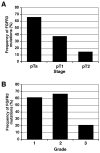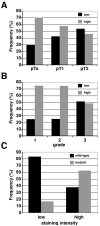FGFR3 protein expression and its relationship to mutation status and prognostic variables in bladder cancer
- PMID: 17668422
- PMCID: PMC2443273
- DOI: 10.1002/path.2207
FGFR3 protein expression and its relationship to mutation status and prognostic variables in bladder cancer
Abstract
FGFR3 is frequently activated by mutation in urothelial carcinoma (UC) and represents a potential target for therapy. In multiple myeloma, both over-expression and mutation of FGFR3 contribute to tumour development. To define the population of UC patients who may benefit from FGFR-targeted therapy, we assessed both mutation and receptor over-expression in primary UCs from a population of new patients. Manual or laser capture microdissection was used to isolate pure tumour cell populations. Where present, non-invasive and invasive components in the same section were microdissected. A screen of the region of the highest tumour stage in each sample yielded a mutation frequency of 42%. Mutations comprised 61 single and five double mutations, all in hotspot codons previously identified in UC. There was a significant association of mutation with low tumour grade and stage. Subsequently, non-invasive areas from the 43 tumours with both non-invasive and invasive components were analysed separately; 18 of these had mutation in at least one region, including nine with mutation in all regions examined, eight with mutation in only the non-invasive component and one with different mutations in different regions. Of the eight with mutation in only the non-invasive component, six were predicted to represent a single tumour and two showed morphological dissimilarity of fragments within the block, indicating the possible presence of distinct tumour clones. Immunohistochemistry showed over-expression of FGFR3 protein in many tumours compared to normal bladder and ureteric controls. Increased expression was associated with mutation (85% of mutant tumours showed high-level expression). Overall, 42% of tumours with no detectable mutation showed over-expression, including many muscle-invasive tumours. This may represent a non-mutant subset of tumours in which FGFR3 signalling contributes to the transformed phenotype and which may benefit from FGFR-targeted therapies.
Figures





References
-
- Knowles MA. Molecular subtypes of bladder cancer: Jekyll and Hyde or chalk and cheese? Carcinogenesis. 2006;27:361–73. - PubMed
-
- Wu XR. Urothelial tumorigenesis: a tale of divergent pathways. Nat Rev Cancer. 2005;5:713–25. - PubMed
-
- WHO Histological typing of urinary bladder tumours. International Histological Classification of Tumours. 1973:10.
-
- Cappellen D, De Oliveira C, Ricol D, et al. Frequent activating mutations of FGFR3 in human bladder and cervix carcinomas. Nat Genet. 1999;23:18–20. - PubMed
Publication types
MeSH terms
Substances
Grants and funding
LinkOut - more resources
Full Text Sources
Other Literature Sources
Medical

